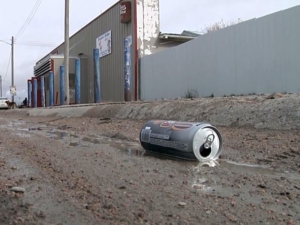 For decades, the Oglala Sioux Tribe has called for an end to alcohol sales at a trading post commonly referred to as Whiteclay, located near the Pine Ridge Reservation border and established over 100 years ago for the sole purpose of dealing alcohol to the residents of Pine Ridge where alcohol sales are prohibited.
For decades, the Oglala Sioux Tribe has called for an end to alcohol sales at a trading post commonly referred to as Whiteclay, located near the Pine Ridge Reservation border and established over 100 years ago for the sole purpose of dealing alcohol to the residents of Pine Ridge where alcohol sales are prohibited.
On April 30, after more than a century, the external flow of alcohol from this beer-trading post onto the reservation, which has had so many negative consequences for the tribal nation, finally came to a halt.
The Nebraska state liquor board voted unanimously in April to deny liquor licenses to Whiteclay beer stores. The closures are a win in the fight against colonial violence; however, they may only be temporary. The case is now headed to the state Supreme Court.
Whiteclay is located in Nebraska, a few minutes’ drive south from the Pine Ridge Reservation—the 8th largest reservation in the country—which exists within the boundaries of South Dakota.
Whiteclay is not a normal village or town. It has no town government or services. In fact, it only boasts of having nine residents and four beer stores that at their peak in 2010 sold 5 million cans of beer to Pine Ridge residents, or 13,000 cans per day. There are no banks on Pine Ridge, so the beer stores double as predatory lenders, cashing welfare and tax refund checks at exorbitant rates.
Whiteclay has come to epitomize how border towns, big and small, cash-in on Native oppression and turn misery and desperation into a multi-million dollar industry.
Pine Ridge Reservation is ravaged by poverty, kept poor by the U.S. government’s sometimes official, sometimes unofficial policy of “de-settling” the reservations so as to end any federal responsibility to fulfill historic treaty obligations, and open those territories up once and for all for unrestrained resource extraction.
The result: 80 percent of residents in Oglala Lakota County, where Pine Ridge is located, are unemployed. One-third of homes lack running water or electricity. Average life expectancy is less than in India, Sudan and Iraq.
“De-settling” through economic deprivation is what lies behind the public health crisis of mass addiction on Pine Ridge, the impacts of which are indescribable. One in four babies are born with Fetal Alcohol Syndrome. One in ten deaths are alcohol related—three times the national average! Poverty and poor conditions of life on the reservation give rise to addiction. This is a struggle that has been ongoing for centuries, imposed by settler-colonialism and capitalism, which has not hesitated to exploit and reap mass profits from the social crisis it created.
Pine Ridge was the site of the famous “Wounded Knee incident” in 1973, when 300 Oglala Sioux and American Indian Movement activists occupied the reservation town Wounded Knee for 71 days to address conditions on the reservation. Their demands included an investigation into the 371 treaties signed between Native nations and the federal government, all of which had been broken.
The U.S. government rejected all of the demands, and a reign of FBI-terror followed the occupation. This reign of terror is what led to Leonard Peltier’s unjust imprisonment in 1975 for his participation in AIM. He is now one of the longest-serving political prisoners in the United States.
It is no coincidence that the Whiteclay beer-trading post has been forced to close, at least temporarily, hot on the heels of the massive Native-led resistance to the Dakota Access Pipeline—what many called this generation’s Wounded Knee.
This demonstrates the resiliency of Native peoples’ struggle for self-determination. Native people have survived a system meant to exterminate them by fighting back, and that tradition of fight-back is alive and well!
What is clear is that the only guarantee that Native nations and all tribal citizens on and off reservation can be free from settler-colonial violence is for all of us to put an end to the predatory U.S. capitalist system.






